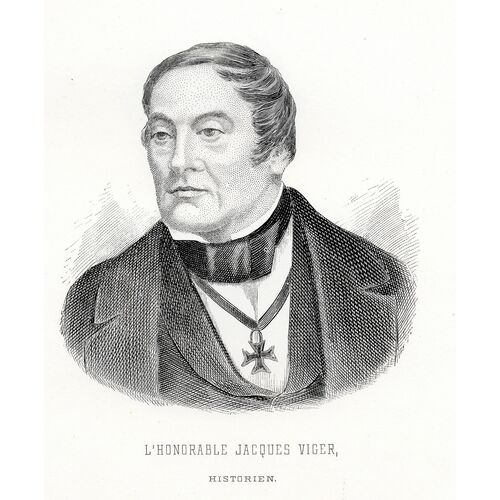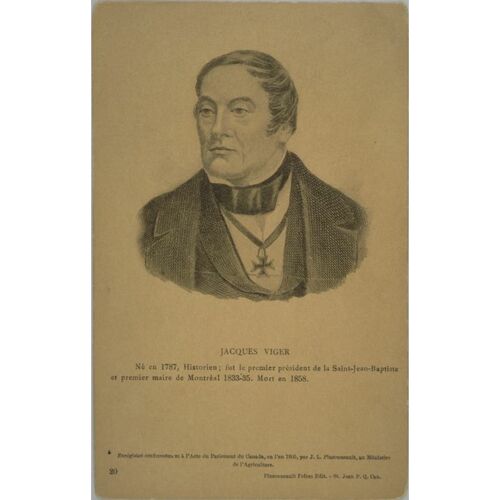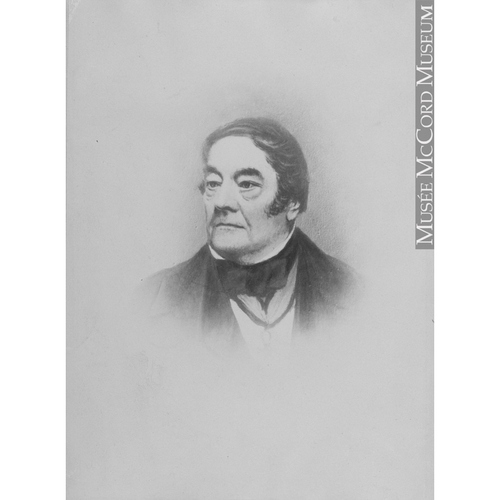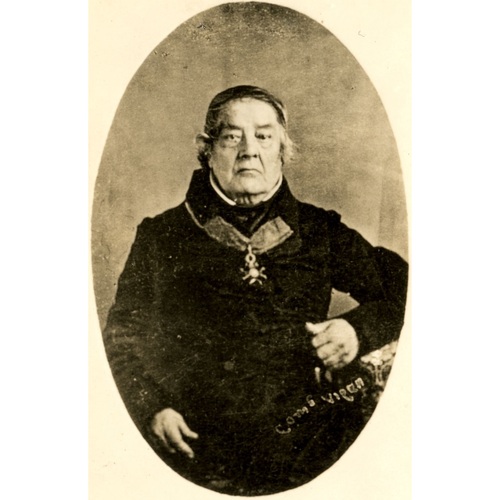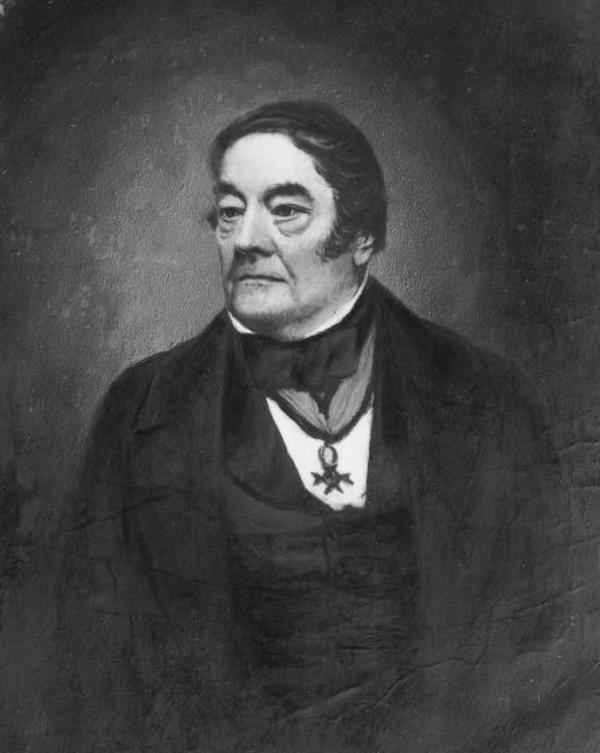
Source: Courtesy of Wikimedia Commons
VIGER, JACQUES, newspaperman, landowner, author, militia officer, office holder, politician, historian, and collector; b. 7 May 1787 in Montreal, son of Jacques Viger and Amaranthe Prévost; m. there 17 Nov. 1808 Marie-Marguerite La Corne, widow of Major John Lennox, and they had three children, all of whom died in infancy; d. there 12 Dec. 1858.
Jacques Viger was part of the powerful network of the Viger, Papineau, Lartigue, and Cherrier families. He was a cousin of Denis-Benjamin Viger*, Louis-Joseph Papineau*, Jean-Jacques Lartigue*, and Côme-Séraphin Cherrier* and kept in constant touch with them all his life, writing or visiting often. He served as a well-informed observer of the Montreal scene for them, and even compiled what in effect were dossiers. He also frequently acted as a courier for one or other of them.
In 1799, at the age of 12, Viger was enrolled in the Collège Saint-Raphaël, an institution run by the Sulpicians which provided a classical education for children of the Montreal bourgeoisie. After his studies he went to Quebec, where he worked as an editor of the newspaper Le Canadien from November 1808 to May 1809. In 1810, soon after his return to Montreal, he prepared a collection of the neologisms he had noted in use; it was to come out a century later as “Néologie canadienne ou dictionnaire des mots créés en Canada.” In 1812 he brought out Relation de la mort de Louis XVI, roi de France by Henry Essex Edgeworth de Firmont, which subsequently appeared in an English version. During the War of 1812 he enlisted as a lieutenant in Montreal’s 3rd Militia Battalion, and later was promoted captain in the Voltigeurs Canadiens. He was at the battle of Sackets Harbor, N.Y., in May 1813, and in August was granted leave to deal with family matters, including the death of his mother. Because of a misunderstanding, George Prevost*, the governor-in-chief of British North America, dismissed him in November for being absent without permission. In March 1814, after the mistake was acknowledged, he was reinstated in his rank.
All his life Viger remained fascinated by military matters, and particularly by what he had experienced while campaigning in the war. Louis-Joseph-Amédée Papineau’s memoirs state that Viger had himself “painted in the uniform of a Voltigeur, with Shako, long sabre and Sabretache.” Viger was also anxious to see the memory of the battle of Châteauguay kept alive. In 1816 he went with his friend Joseph-D. Mermet, a French royalist officer in the service of Great Britain, to the battleground, and he did a great deal to promote an engraving of the hero of Châteauguay, Charles-Michel d’Irumberry* de Salaberry.
However, Viger’s own military career was unremarkable, apart from the incident of his dismissal. Following reinstatement, he served in the militia until the end of his life. For example, he held various posts including that of lieutenant-colonel in Montreal’s 3rd Militia Battalion, an appointment he received in 1829. Historian Fernand Ouellet thinks that this interest partly stemmed from the desire of French Canadians at the beginning of the 19th century to express and demonstrate their loyalty to the authorities. According to him, Viger was motivated by a desire to show that the conduct of his compatriots in time of war was beyond suspicion. This interest later took a different turn when Viger sought to reconstruct the military tradition of New France. Hence Ouellet sees a direct link between the climate of the early 19th century and the scholarly works of Viger.
Meanwhile, in December 1813 Viger had replaced Louis Charland* as surveyor of highways, streets, lanes, and bridges of Montreal. At that time local government was in an early stage of development. The justices of the peace who were charged with responsibility for the town’s administration had at their disposal few powers and still fewer officials, chief of these being the surveyor of highways, streets, lanes, and bridges. In this capacity Viger prepared reports, saw to the grading of highways, the realignment of routes, and drainage, levelling, and paving operations. He bought stone, made arrangements for construction, and signed various supply contracts. He was also involved in enforcing police regulations.
Viger’s activity led him to engage in rudimentary town planning. For example, when the mound where the Montreal citadel had stood (near the present Champ-de-Mars) was levelled, the question of how some of the cleared land should be used had to be resolved. To this end Viger drafted a plan which provided for the extension northwards of Rue Bonsecours. His endeavours did not please everyone but because he had been appointed by the governor of the colony he was not wholly under the jurisdiction of the justices of the peace. When one of them apparently remonstrated with him about the plan, Viger ignored his remarks and got a lawyer friend to present it to the governor.
As surveyor Viger also drafted a number of reports. For example, he appeared before the House of Assembly of Lower Canada in 1825 with a report, which came out first in the journal of the assembly that year and then was published as Observations en amélioration des lois des chemins telles qu’en force dans le Bas-Canada en 1825 through his own efforts 15 years later. In 1841 he brought out his Rapports sur les chemins, rues, ruelles et ponts de la cité et paroisse de Montréal, avril et mai 1840. These two publications were probably pleas to the city council in support of his work. In addition, to help him carry out his duties, he had two Montreal street directories drawn up, in 1817 and 1837.
In 1825 Viger was also appointed, with Louis Guy*, census commissioner for Montreal County, which then covered Montreal Island. The document of exceptionally high quality which he produced was an indication of his desire to acquire detailed knowledge of his own society. For instance, he added to the questionnaire required by the census law a series of his own questions that make this document an excellent source of information for reconstructing the history of Montreal.
Viger unsuccessfully sought or aspired to some other public offices. For example, he solicited the position of inspector of police at Montreal in 1820. In 1825 he wanted to become a justice of the peace and commissioner of the House of Correction at Montreal. There was talk of his being made commissioner for Trinity House of Montreal in 1830, and in 1832 he applied for the post of overseer of highways. On the other hand, in the period 1829–36 he held various appointments as commissioner, among them to improve the roads in and around Montreal.
Although he was involved in public affairs, Viger did not take much part in politics. He held only one important office, serving as the first mayor of Montreal, from 1833 to 1836. It was probably no coincidence that he was elected to the mayoralty. In 1828 he had advised his cousins Louis-Joseph Papineau and Denis-Benjamin Viger, who were both members of the assembly, not only on boundaries for the wards in the town, but also on the importance of keeping the property qualification low enough for the majority of small owners to vote. He thus deliberately ensured that French Canadians formed the majority of voters. Adam Thom* and William Kennedy, in their study on municipal government for the report of Lord Durham [Lambton*], indicated they understood the reasons for the criteria adopted and denounced them as weakening the power of the British merchants, who were paying a large share of municipal taxes. Occupying an important place on the municipal scene through his position as roads surveyor, Viger gave advice to his cousins at the time of the assembly debates on the bill to incorporate Montreal. The statute of incorporation passed in 1832 was the result of a compromise between the city’s merchants and the supporters of Papineau’s party there. The former wanted the Patriote party’s backing to have Montreal declared a port of entry not subject to the supervision of the port of Quebec, while the latter sought municipal incorporation to remove Montreal from the control of the justices of the peace, who were responsible to the governor and who were unpopular in the town.
Things quickly took a turn for the worse. Soon after incorporation Montreal was shaken by two events that left deep scars and widespread distrust. The first was the intervention of British troops during a by-election for Montreal West in May 1832, which resulted in the death of three French Canadians [see Daniel Tracey*]. Then, at the beginning of June a cholera epidemic broke out, killing at least 2,000 Montrealers, with French Canadians being the worse stricken. Viger’s election as mayor in 1833 failed to restore calm. Anxious to avoid a repetition of the troubles of 1832, Viger intervened in the 1834 election campaign by having the men of the watch maintain order, a step that earned him bitter criticisms from the conservative press. He was further reproached for holding the offices of both mayor and roads surveyor, and thus neglecting part of his duties. From 1833 to 1836 he had major drainage operations carried out in the faubourgs of the city. It was a period in which cholera raged and its virulence was being blamed partly on the marshy state of the area north of Rue Sainte-Catherine, at the foot of the slope rising to Rue Sherbrooke. François-Maximilien Bibaud* later noted that Viger should be credited with the improved sanitation of these faubourgs. However, the city’s revenue base was limited, both before and after its incorporation, and the work was done at the expense of the upkeep of other streets. When the law setting up the municipality expired in 1836, the previous system of government by justices of the peace was re-established, and thus Viger’s office as mayor was eliminated. Four years later, when a new charter came into force, Viger was dismissed from his post as roads surveyor and replaced by John Ostell*, probably because the Montreal roads were still in poor repair and because he was regarded as suspect by reason of family ties. From then on his livelihood depended on income from a few properties he owned in Montreal as well as from the offices he held as commissioner for the erection of parishes and the building of churches and as member of the Rebellion Losses Commission.
Politically, Viger was in sympathy with Papineau’s party – witness his roles as a source of information and messenger, as well as his correspondence. He presided at the first banquet of Saint-Jean-Baptiste Day in 1834. Although, like many Montrealers, he did not play an active part in the rebellion, this did not keep him from supporting Ludger Duvernay during his imprisonment in 1836. His quite moderate political stand, together with the obligations of his office as roads surveyor, presumably explains this attitude, for which he was severely criticized the next year by Papineau. Six years later he was a member of the organizing committee for the Association Saint-Jean-Baptiste de Montréal, and in 1856 he was elected its president.
Viger often helped run elections. According to his biographers he served as returning officer eight times. His love of detail makes some of his expense claims a good source of information on the whole electoral process. Even when playing no precise role, he took copious notes, which were the basis of valuable reports, for example during the 1832 election.
It was, however, by his work as scholar and collector that Viger made himself best known during his lifetime. He had a remarkable determination to discover and understand far exceeding the curiosity of a local expert. Indeed, when he interested himself in Montreal County, following his inquiry at the time of the 1825 census, the various calculations he produced and included in the “Tablettes statistiques du comté de Montréal en 1825” show his concern to understand how society functioned. He calls to mind the first amateur statisticians, who in concentrating on “social mathematics” and its explanatory potential foreshadowed the development of statistics and the social sciences in the late 19th and early 20th centuries. The value of his studies was recognized, particularly by John Holmes, who reprinted extracts of the “Tablettes statistiques” in his own 1831 work, Nouvel abrégé de géographie moderne suivi d’un petit abrégé de géographie ancienne à l’usage de la jeunesse. Some authors also claim that Viger collaborated with Joseph Bouchette*, either in developing the first map of Montreal or by contributing to his descriptive works. There appears to be some confusion about the help Viger provided and about how the map was created, as well as about whether Bouchette plagiarized William Berczy*’s work. Finally, Viger’s reputation as a scholar brought him requests for information from all sides. Historians such as Étienne-Michel Faillon* and Francis Parkman* had recourse to his services, and his correspondence gives an indication of requests from other scholars, as the references in his letters to Pierre Margry illustrate.
Viger’s more historical works deal with religious institutions. His Archéologie religieuse du diocèse de Montréal, published at Montreal in 1850, provides short accounts of the parishes in the diocese, with a list of officiating priests. In 1853, in honour of the visit of the papal nuncio, Mgr Cajetan Bedini, Viger prepared for him a series of water-colours depicting the apparel of the various religious orders for French Canadian women. As a result he was appointed commander of the papal order of St Gregory the Great in 1855. While preparing the collection Viger wrote accounts of each of the communities, which he transmitted to the French ultramontane Henry de Courcy. The latter, using the pseudonym C. de La Roche-Héron, produced a book of them, which was published in 1855 as Les servantes de Dieu en Canada: histoire des communautés religieuses de femmes de la province.
These various works made Viger an archivist as well as an historian. At this period in the development of French Canadian historiography, there was apparently as much preoccupation with writing history as with preparing “memoirs” on various subjects that would eventually make such writing possible. Viger clearly belonged to the second school, writing most often as a memorialist. He began with his recollections of the War of 1812 in “Mes tablettes de 1813,” but it was particularly in his monumental 43-volume “Ma saberdache” that he recorded his observations. There were two series in this collection, which he began in 1808: the first, 30 volumes called “Saberdache rouge,” included various materials that could be drawn on for a history of the Canadas; the second, 13 volumes called “Saberdache bleue,” contained Viger’s correspondence, notes, and various documents. These were not memoirs in the accepted sense, but rather diverse comments on events in which he had been involved. He contributed to Le Spectateur canadien, and then to his friend Michel Bibaud’s Bibliothèque canadienne, publishing numerous extracts of “Mes tablettes” and “Ma saberdache.” Concerning the books brought out by contemporary historians, Viger was harsh in his criticism. As an ultramontane he had little respect for the works of François-Xavier Garneau*, or of Charles-Étienne Brasseur* de Bourbourg, whom in his letters he nicknamed “Brasseur de Boue” (muckraker). However, apart from his ideological biases, he paid serious attention to accuracy and to the critical use of documents.
Viger’s concerns as an archivist were matched by his tastes as a collector. For most of his life he gathered documents and material on the history of Canada, literature, and other subjects. His collections contain a bit of everything. In this respect his “Albums” are representative. Water-colours and original drawings are next to reproductions and decorative items, for example a design in lacy paper created by patient toil but significant only for its detail. Given Viger’s keen interest in the preservation of old documents, it is not surprising that in 1858 along with several other scholars he helped found the Société Historique de Montréal, of which he was elected the first president. He was involved in preparing the first instalment of the society’s transactions which came out in 1859, a year after his death. The collection included a study entitled “De l’esclavage en Canada,” which Viger had prepared with Louis-Hippolyte La Fontaine*. The society was incorporated that year.
Viger was also interested in education. His 1825 census of Montreal contained specific notes on the staff of the schools he had located, along with information on the pupils and the curricula. In 1829 and 1835 he made a detailed list of the educational institutions in Montreal. In 1836 he was a member of the committee that administered the École Normale de Montréal. It is thus not surprising that Charles Buller* sought his help in preparing the inquiry into education he carried out for the Durham report. Subsequently Viger was recommended by Ignace Bourget*, the bishop of Montreal, for the post of superintendent of education for Lower Canada, but the governor, Sir Charles Bagot*, chose to appoint Jean-Baptiste Meilleur*.
Viger’s relations with the church were always extremely cordial. From the time his cousin Jean-Jacques Lartigue was made auxiliary in Montreal to the bishop of Quebec in 1820, Viger backed him in his dispute with the Sulpicians concerning the cathedral and even got letters by Lartigue published under a pseudonym in the Montreal papers. Viger enjoyed Bourget’s confidence during his episcopacy.
Viger apparently was not wealthy, but he had sufficient means to live in comfort. According to Fernand Ouellet, Viger improved his financial position at the beginning of his career when through his marriage he benefited from the Lennox estate. In succeeding years he seems to have maintained himself at the level he attained then. In addition to his salary as an office holder, he received income from a few properties. Notarial minute-books indicate that he engaged in various property transactions. In 1811 and 1812 he and his mother jointly sold some lots on Rue Saint-Paul in Montreal that were part of his father’s estate. In 1816 he sold the Saint-Jean sub-fief in the seigneury of Boucherville, which he had also inherited upon the death of his father in 1798. In 1816 as well he disposed of some lots he had purchased from Joseph Papineau* on Rue Sanguinet in Montreal; at the same time he bought some land in the Faubourg des Récollets and jointly with his wife acquired a property on Rue Bonsecours, where he was to live for the greater part of his life. He sold his house on Rue Saint-Paul in 1832, and a lot in Saint-Antoine ward in 1840. The properties were sometimes rented out – for example one on Rue Saint-Paul and one on Rue Bonsecours which was eventually occupied by an innkeeper. The 1842 census gives a glimpse of his household: the Vigers lived with their three daughters-in-law, two maidservants and one manservant; they also had a horse and a cow, a not uncommon practice at that time, even in the city. In 1858 Viger still owned the lot on Rue Bonsecours. However, at the time of his death his debts exceeded his assets, and thus the heirs handed all his property over to the Misses Lennox, Viger’s stepdaughters and the principal creditors of the estate.
It is not easy to grasp the many sides of Jacques Viger’s life. His personality, the range of his activity, and the diversity of his interests marked him as unusual. As Ouellet says, he was an enigmatic and disconcerting person. All the details of his fellow-citizens’ lives were known to him – his 1825 census enumerated all the houses and their occupants, including the least commendable. He was not very handsome, but his lively mind, caustic rejoinders, and proverbial joviality gave him his charm. Moderate in politics when the 1830s began, then firmly ultramontane after the rebellion, he exemplified the ambiguities and problems that beset one part of the petite bourgeoisie of French Canada in the first half of the 19th century. This group vacillated between liberalism and a form of nationalism, and finally chose the path of reform and moderation, and even of conservatism. By the end of his life Viger was a man of renown, as is evidenced by the title of commander which he bore proudly, his military rank, and his participation in a number of learned societies. His writings placed him among the intellectuals who sought to understand the workings of their society. His substantial collection of more than 1,200 books and his documents were purchased by friends, among them Hospice-Anthelme-Jean-Baptiste Verreau*.
The Fonds Viger–Verreau at the ASQ is the chief source of information on Jacques Viger. It includes Viger’s “Ma saberdache” (sér.O, 095–125, 0139–52) and his personal journal (sér.O, 0165–71). An inventory by Fernand Ouellet of the “Saberdache” was published in ANQ Rapport, 1955–57: 31–176. The Fonds Viger–Verreau also includes Viger’s “Album”; another “Album” is at the BVM-G.
The collection of neologisms that Viger prepared in 1810 was published a century later as “Néologie canadienne ou dictionnaire des mots créés en Canada et maintenant en vogue; – des mots dont la prononciation et l’orthographe sont différentes de la prononciation et orthographe françaises, quoique employés dans une acception semblable ou contraire, et des mots étrangers qui se sont glissés dans notre langue” in Bull. du parler français au Canada (Québec), 8 (1909–10): 101–3, 141–44, 183–86, 234–36, 259–63, 295–98, 339–42. Viger’s historical works include Archéologie religieuse du diocèse de Montréal (Montréal, 1850) and Archéologie canadienne: souvenirs historiques sur la seigneurie de La Prairie (Montréal, 1857). With Louis-Hippolyte La Fontaine he also wrote the essay “De l’esclavage en Canada,” which came out in the first issue of Soc. hist. de Montréal, Mémoires (Montréal), 1 (1859): 12–65. In addition, Viger produced excellent works while discharging his official duties, in particular Observations en amélioration des lois des chemins telles qu’en force dans le Bas-Canada en 1825 (Montréal, 1840); Rapports sur les chemins, rues, ruelles et ponts de la cité et paroisse de Montréal, avril et mai 1840 (Montréal, 1841); and “Tablettes statistiques du comté de Montréal en 1825,” held at ASQ, Fonds VigerVerreau, sér.O, 018A. Further information on the last document can be found in P.-A. Linteau et J.-C. Robert, “Un recensement et son recenseur; le cas de Montréal en 1825,”Archives (Québec), 8 (1976–77), no.2: 29–36.
ACAM, 901.023. ANQ-M, CE1-6, 15 déc. 1858; CE1-51, 7 mai 1787, 17 nov. 1808; CN1-7, 14 juin 1836; CN1-134, 19 mai 1840; CN1-243, 28 févr. 1816; CN1-270, 13 mars 1832; CN1-295, 19 mars 1816, 6 nov. 1825; CN1-312, 8 janv. 1859; CN1-313, 18 déc. 1819; CN1-334, 22 mars 1811; 5–6, 8, 13 mai, 13 juill. 1812; 30 juill. 1813; 3 juin 1814; 11 janv., 21, 26–27 nov. 1816; 17 janv., 31 juill. 1817; P-24; P1000-3-383; P1000-5-516; P1000-20-709; P1000-49-1097. Arch. de la ville de Montréal, Dossier surintendant, inspecteur, directeur des travaux publics depuis 1796; Dossiers Jacques Viger; Procès-verbaux des juges de paix. ASQ, Fonds Viger–Verreau, cartons 22, no.38; 62, no.196a; sér.O, 015A, 018A, 021. PAC, MG 24, B2; MG 24, L3; MG 30, D1, 30: 415; RG 31, A1, 1831, 1842, Montreal; RG 68, General index, 1651–1841, 1841–67. Marius Barbeau, “Vieux papiers,” Le Canada français (Québec), 2e sér., 26 (1938–39): 286–96. Can., Prov. of, Statutes, 1859, c.119. “Documents inédits,” RHAF, 6 (1952–53): 110–11. Election of the West Ward of the city of Montreal 27 March 1810 from the poll books alphabetically arranged (Montreal, n.d.). [J. G. Lambton], Lord Durham’s report on the affairs of British North America, ed. C. P. Lucas (3v., Oxford, Eng., 1912; repr., New York, 1970). L.C., House of Assembly, Journals, 1825, app.X; Statutes, 1831, c.54. Lettres à Pierre Margry de 1844 à 1886 (Papineau, Lafontaine, Faillon, Leprohon et autres), L.-P. Cormier, édit. (Québec, 1968). Le Courrier du Canada, 15 déc. 1858. La Minerve, 15 déc. 1858. L’Ordre (Montréal), 14 déc. 1858. Le Pays, 14 déc. 1858. Beaulieu et Hamelin, La presse québécoise, vol.1. F.-M. Bibaud, Le panthéon canadien (1858; A. et V. Bibaud, 1891). DOLQ, vol.1. F.-X. Grondin, “Bio-bibliographie de Jacques Viger” (thèse de bibliothéconomie, univ. de Montréal, 1947). Reginald Hamel et al., Dictionnaire pratique des auteurs québécois (Montréal, 1976). Le Jeune, Dictionnaire. Montreal directory, 1820, 1842–58. Wallace, Macmillan dict.
Chaussé, Jean-Jacques Lartigue. Serge Gagnon, Le Québec et ses historiens de 1840 à 1920: la Nouvelle-France de Garneau à Groulx (Québec, 1978). Pierre de Grandpré, Histoire de la littérature française du Québec (2e éd., 4v., Montréal, 1971–73), 1. F.-X. Grondin, Jacques Viger (Montréal, 1942). Labarrère-Paulé, Les instituteurs laïques. Robert Lahaise, Les édifices conventuels du Vieux Montréal: aspects ethno-historiques (Montréal, 1980). Monet, La première révolution tranquille. Montréal: artisans, histoire, patrimoine, Henri Béchard et al., édit. (Montréal, 1979). Fernand Ouellet, Histoire économique et sociale du Québec, 1760–1850: structures et conjoncture (Montréal et Paris, [1966]). Gérard Parizeau, La vie studieuse et obstinée de Denis-Benjamin Viger (1774–1861) (Montréal, 1980). Meilleur, Mémorial de l’éducation (1860), 174. Pouliot, Mgr Bourget et son temps, vols.1–5. J.-C. Robert, “Montréal, 1821–1871; aspects de l’urbanisation” (thèse de phd, univ. de Paris, 1977). Robert Rumilly, Histoire de la Société Saint-Jean-Baptiste de Montréal: des patriotes au fleurdelisé, 1834–1948 (Montréal, 1975); Histoire de Montréal (5v., Montréal, 1970–74), 2–3. L. J. Ste Croix, “The first incorporation of the city of Montreal, 1826–1836” (ma thesis, McGill Univ., Montreal, 1971). Jules Bazin, “L’album de consolation de Jacques Viger,” Vie des arts (Montréal), 17 (Noël 1959): 26–30. L.-O. David, “Viger,” La Patrie (Montréal), 8 mai 1926: 31. France Galarneau, “L’élection partielle du Quartier-Ouest de Montréal en 1832: analyse politico-sociale,” RHAF, 32 (1979): 565–84. J.-J. Lefebvre, “La famille Viger: le maire Jacques Viger (1858); ses parents – ses ascendants – ses alliés,” SGCF Mémoires, 17 (1966): 203–38. É.-Z. Massicotte, “Jacques Viger et les Centenaires,” BRH, 33 (1927): 100–2; “Jacques Viger et sa famille,” 21 (1915): 148–49; “Jacques Viger et sa famille: autres notes,” 24 (1918): 209. Olivier Maurault, “Souvenirs canadiens; album de Jacques Viger,” Cahiers des Dix, 9 (1944): 83–99. Victor Morin, “Esquisse biographique de Jacques Viger,” RSC Trans., 3rd ser., 32 (1938), sect.i: 183–90. Gérard Morisset, “L’album de Jacques Viger,” Vie des arts, 8 (automne 1957): 15–18. Camille Roy, “Jacques Viger,” Bull. du parler français au Canada, 8 (1909–10): 42–55. Claude Tousignant, “Michel Bibaud: sa vie, son œuvre et son combat politique,” Recherches sociographiques (Québec), 15 (1974): 21–30.
Cite This Article
Jean-Claude Robert, “VIGER, JACQUES,” in Dictionary of Canadian Biography, vol. 8, University of Toronto/Université Laval, 2003–, accessed April 16, 2025, https://www.biographi.ca/en/bio/viger_jacques_8E.html.
The citation above shows the format for footnotes and endnotes according to the Chicago manual of style (16th edition). Information to be used in other citation formats:
| Permalink: | https://www.biographi.ca/en/bio/viger_jacques_8E.html |
| Author of Article: | Jean-Claude Robert |
| Title of Article: | VIGER, JACQUES |
| Publication Name: | Dictionary of Canadian Biography, vol. 8 |
| Publisher: | University of Toronto/Université Laval |
| Year of revision: | 1985 |
| Access Date: | April 16, 2025 |


